[View the foreward.]
(late November 2023)
Despite being nearly 3 months since Grabby's death, I still find myself waiting for her to come to the food dish at dinner time, to be on the bathroom counter when I step out of the shower, and to be present in any number of other situations. In my mind I can still picture that gimlet-eyed look she'd send my way when I entered a room where she was relaxing.
"Gotta keep an eye on those pesky humans!" she no doubt thought to herself.
I have also not stopped using her name. When I should be saying "Pipe!" or "Piper!", I am still exclaiming "Grabby and Pipey!" or "Grab and Pipe". Old habits die hard. Lord help me when we get another cat and I find myself blurting out three names.
While I wait for my brain to adjust, I figure it's best to keep myself occupied.
November started with a trip down to Chicago to see Steve Hackett in concert. He was the guitarist in the progressive rock band Genesis from 1970-77 and has 28 solo albums to his credit. He was to perform at the Copernicus Center, a venue I’d never been to.
Before the show, I met up with a quartet of friends/fellow concert goers at Iztatl Cocina Mexicana in Jefferson Park where I gorged myself on a tasty burrito as we chatted away until showtime was nigh. I’d gotten to know all of them through my brother and it seemed very fitting to be going to see Steve Hackett with them as he would have no doubt come along if he’d still been alive, work commitments notwithstanding.
Walking into the theater, I found it to be a beautiful, old venue.
I have since learned that it is the former Gateway Theatre, a movie palace dating back to 1930. It was the first movie theater in Chicago built exclusively for the talkies, apparently.
The show was similarly structured to the one my Frau and I had attended last spring in Minneapolis with a set of Hackett’s solo work followed by an intermission and then a second set comprised of Genesis material. I was delighted to find that our guitar hero had revamped the first set so that we were given a larger dose of his solo music and that it featured mostly different songs than he played last year. The second set was again a Genesis album in its entirety. However, instead of the live album Seconds Out, he played their 1972 opus Foxtrot.
It was a remarkable show! A couple of the songs from Foxtrot had never been played live by Genesis after the Foxtrot tour ended in 1973 and the band had never played one of the songs live ever. So it was a real treat to hear these rarely/never performed songs brought to life.
Again my eyes welled with tears during the 25 minute epic "Supper’s Ready" just as they had in Minneapolis. And just as he did last year, Hackett (and the band) brought the first set to a close with the instrumental section of "Shadow of the Hierophant". While I've always liked the song, I felt that Sally Oldfield's vocals on the studio version were rather twee for the longest time, as if they were some Hobbit maiden's hymn. At some point, I matured or got old or something and I just fell in love with them with their gentle clarity and delicate resonance. I hope to witness that song performed in full someday. And just as he did last time, Craig Blundell proved to be a monster on drums. His playing added so much excitement and dynamics to the performance. The song built in intensity with no small debt to his percussive prowess.
What a wonderful show!
Later in the month the Frau and I attended a performance by the Madison Symphony Orchestra and I am reminded that we went to see the Wisconsin Chamber Orchestra perform back in October. It had slipped my mind when writing the previous entry because, unlike the MSO, the WCO does not send you an email afterwards with photographs from the concert. Without the visual reminders, I forgot to mention it last time.
The performance was called Harmony in Black and was part of a WCO initiative to feature the works of underrepresented composers of color. It featured two pieces by Dr. Bill Banfield, composer in residence at the WCO.
In addition, there was a piece by Patrice Rushen, who has composed jazz and pop music and holds a chair at USC Thornton School of Music.
Their music drew inspiration from Frederick Douglass, Paul Robeson, and Dr. Martin Luther King and, I suppose, the black experience in America, generally.
Rushen’s "Mine Eyes Have Seen the Glory" opened the concert. Its three movements draw on King’s life and career. The first is called "Passion from the Pulpit" and began with an excerpt from King’s speech that contained the piece’s title. It then proceeds through a series of sections that alternate those that are faster with a dose of the dramatic and ones that are slower with a more pensive tone.
The second movement, "The Dreamer Cometh", is darker and moody. Perhaps it reflects King’s recognition of the struggles of his present and of his future while dreaming of the fulfillment of his life’s mission.
"Freedom Is Not Free" ends the piece. It begins with big, sweeping brass and transitions to a feeling of urgency led by a martial sounding snare drum. This tone would last until the piece reaches its denouement with another recording of King.
Banfield's "Testimony of Tone, Tune, and Time" reflected on Douglass and Robeson. The music was dotted with brief interludes featuring a narrator reading the words of these men. Joining the orchestra was a saxophonist who added tonal color as well as a distinct jazz element.
The 8 movements were fairly short and each had its own flavor. There was sadness, joy, tenderness, a contemplative mood, etc.
Another piece by Banfield, Symphony No. 8, closed the performance but my Frau's back pain was causing her extreme discomfort so we weren’t able to stay to hear it. Luckily the whole concert was recorded and is set to be released (even on CD!) in February.
Back here in November, the Frau and I attended a performance by the Madison Symphony Orchestra. We went down to the lovely Overture Center where we joined the great and the good for "Symphony Gems". On the bill were Mozart, Schumann, and William Levi Dawson.
I was unfamiliar with the opener, Mozart's Symphony No. 35 in D Major, K. 385, "Haffner". Almost right out of the gate the first movement was cookin'. The violinists were on fire and the piece really moved. Crescendos came replete with deep reinforcement from tympani.
The second movement was slower, but the violins couldn't be calmed completely as they contributed some rapid bowing to punctuate the gentle passages. Woodwinds were more prominent on the mid-tempo third movement while the fourth picked up the pace once again and the tympani made a triumphant return. It ended on a rousing note.
Schumann’s Concerto in A Minor for Piano and Orchestra, Op. 54 came next. Guesting on the piano was a gentleman named Jonathan Biss. Hailing from Philadelphia, his CV is chock full of performances with orchestras around the country and around Europe as well.
This was another piece that I'd never heard before and I was delighted by it. The first movement revels in dynamics. But whether it was a slow passage or something more spirited, Biss would throw in short bursts that cut through the symphonic sonorities of the orchestra. And then his playing became more sustained and melodic as the piano joined the orchestra in blissful melody.
The middle movement was slow and graceful while the final one upped the tempo again and featured some wonderful, dramatic soloing from Biss. That guy was animated too. There were times I thought he was going to jump up from the bench and launch into some kind of Jerry Lee Lewis routine.
William Levi Dawson's Negro Folk Symphony began slowly and a bit on the sullen side. Then waves of strings were joined by a simple tympani rhythm before the orchestra falls silent briefly. Brass takes over and a sprightly melody ensues. And so the first movement went with slow, gentle passages giving way to more rousing ones.
The second movement features slower, forlorn sounding sections sitting next to brighter, faster ones. This movement is called Hope in the Night and perhaps the slower parts are the night and the faster ones represent hope, some light in the darkness.
The third and final movement is generally upbeat with different parts of the orchestra repeating melodic lines in sequence. This final bit never really lets up and has an exuberance throughout that comes to a conclusion in the big, dramatic finale. O, Le’ Me Shine, Shine Like a Morning Star is an apt title.
********
We had a couple interesting animal sightings this month.
The first came when my Frau was out in the carport looking at her phone. Suddenly a loud noise rent the air...
THWAP!
She looked over at her car which was sitting in the driveway and saw that a hawk had landed on the roof.
Upon closer inspection, she discovered that Nature is truly red in tooth and claw as our avian visitor had come with its dinner.
Poor squirrel. But hawks gotta eat too.
We had a little snowfall one night and, upon going outside the following morning, I saw tracks.
There were turkeys about! I didn’t see them, however. Later, though, the Frau did. They were strutting through the backyard.
********
Just a day or 2 ago I received a text from a friend of mine that was simply a photograph.
That headless figure is his sister and she’s at their mom’s house up in Portage (about 30 miles north of Madison) making lefse.
Lefse is a Norwegian potato flat bread. While I have 3 brands on offer at my local supermarket, homemade remains the best. Folks in Wisconsin of Norwegian stock are known to make it for the holidays.
I replied saying I hoped that some of that would come my way.
********
Bonus photo. Here is a recent photo of Piper relaxing on the couch, no doubt patiently awaiting pets from her cat dad. Or perhaps wondering why he is putting this strange device in her face.
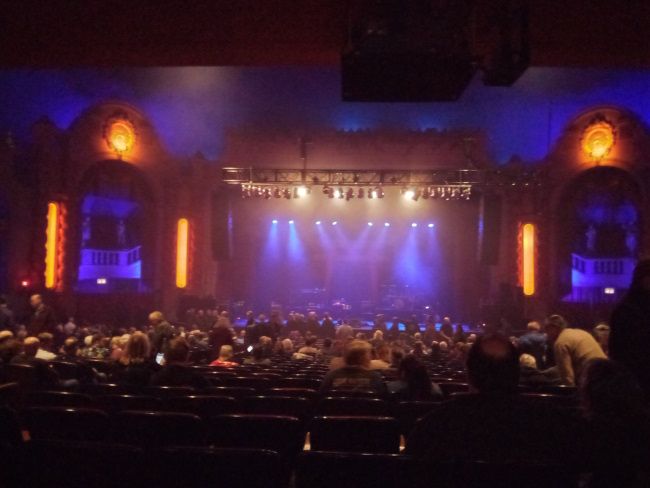
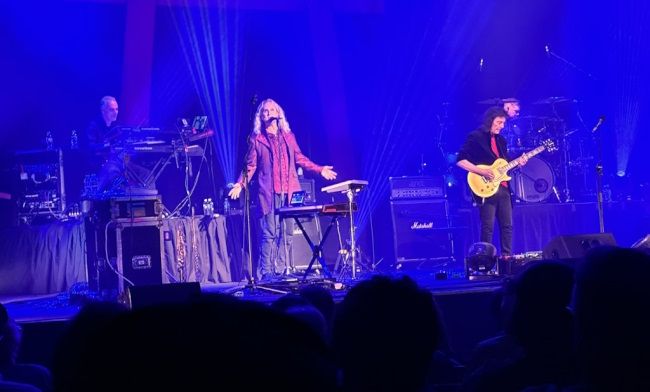
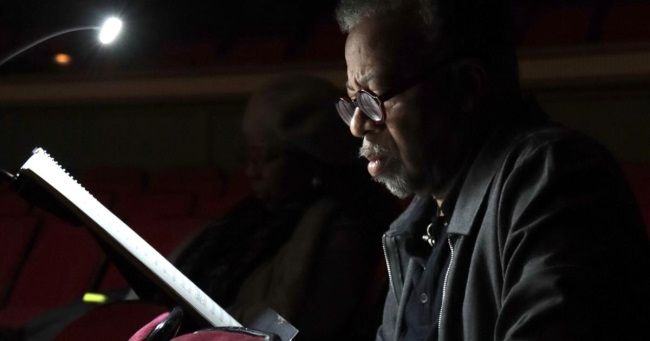
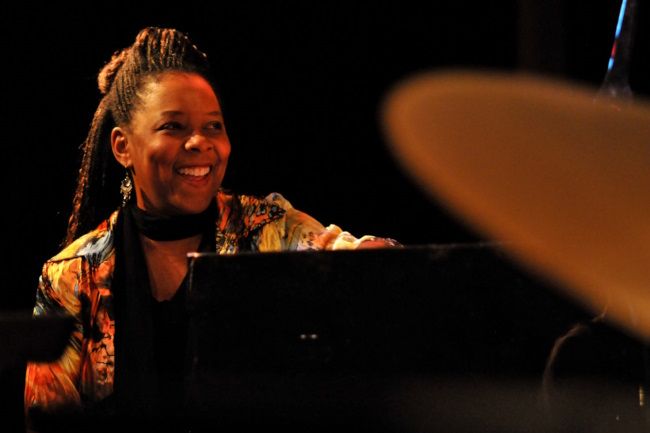
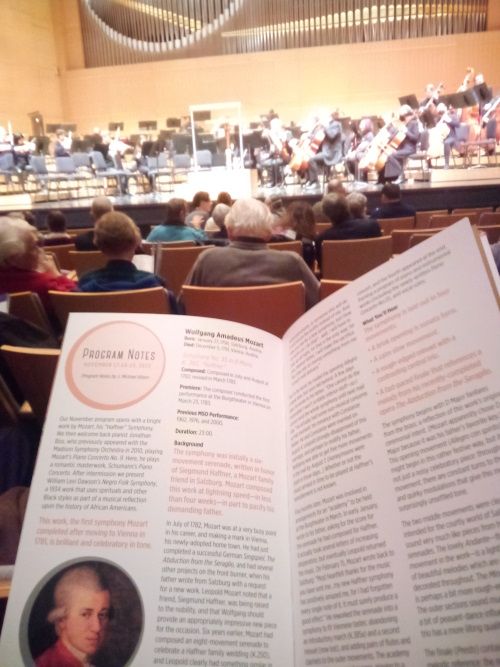
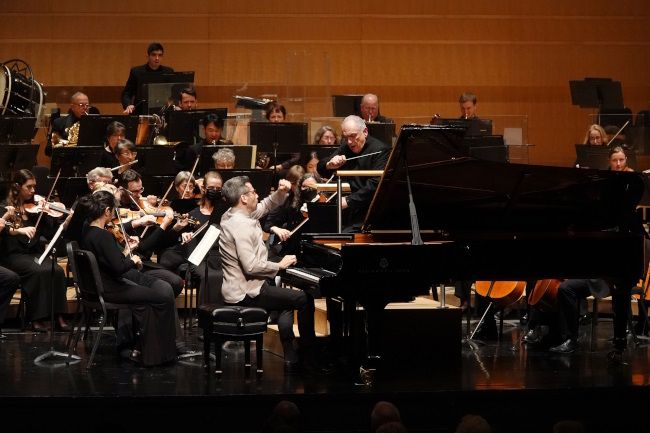
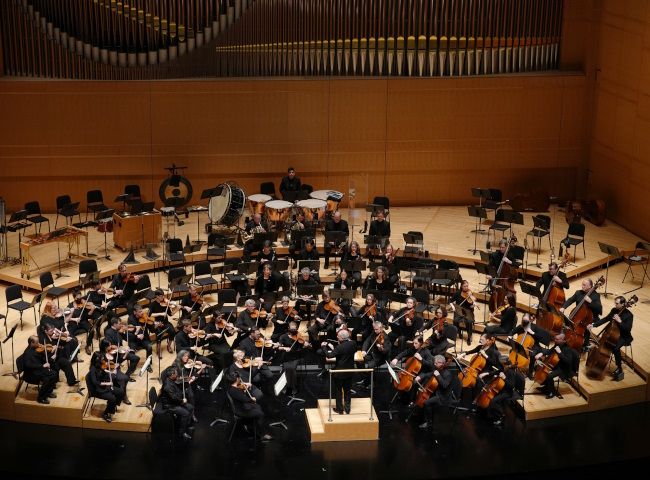
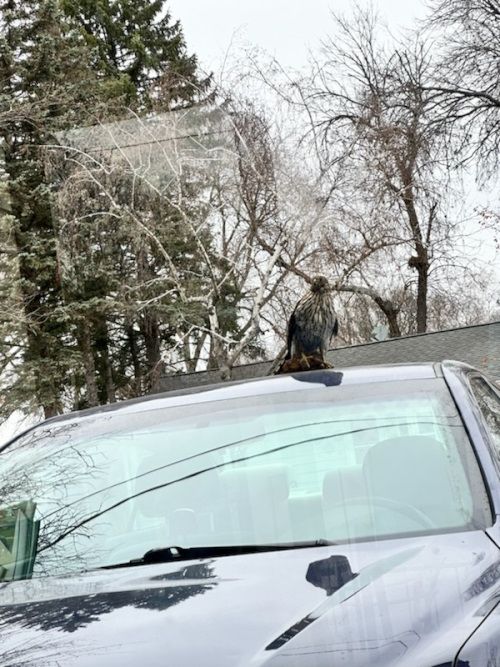
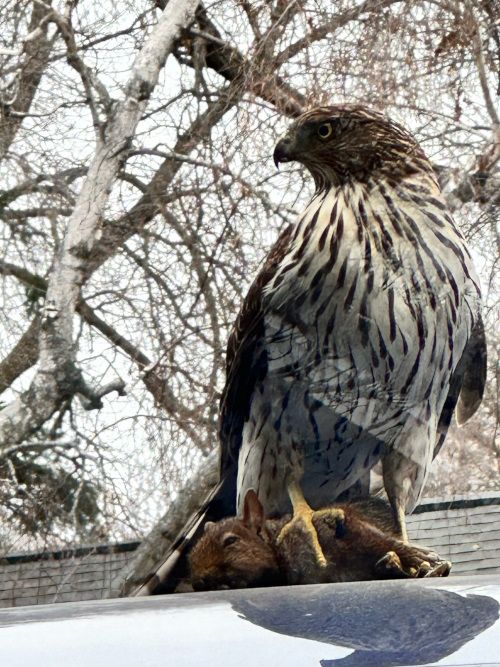
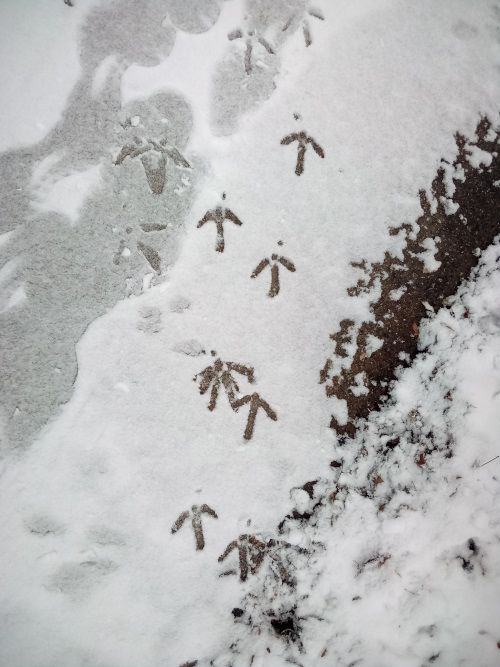
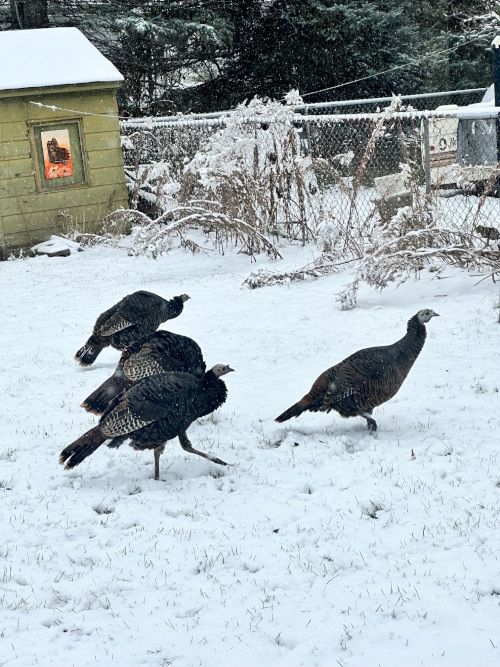
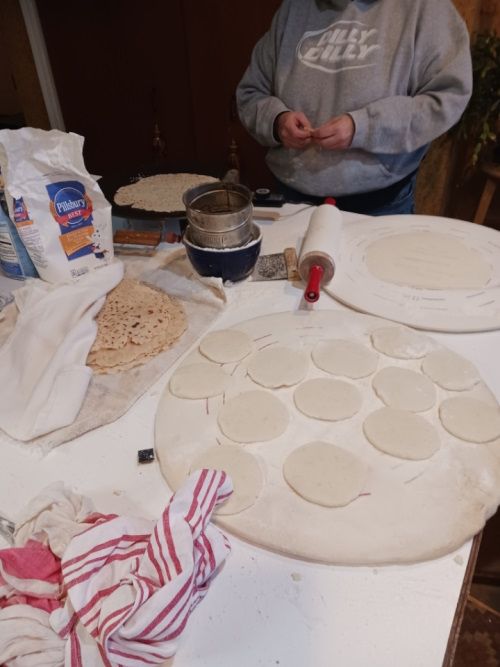

No comments:
Post a Comment